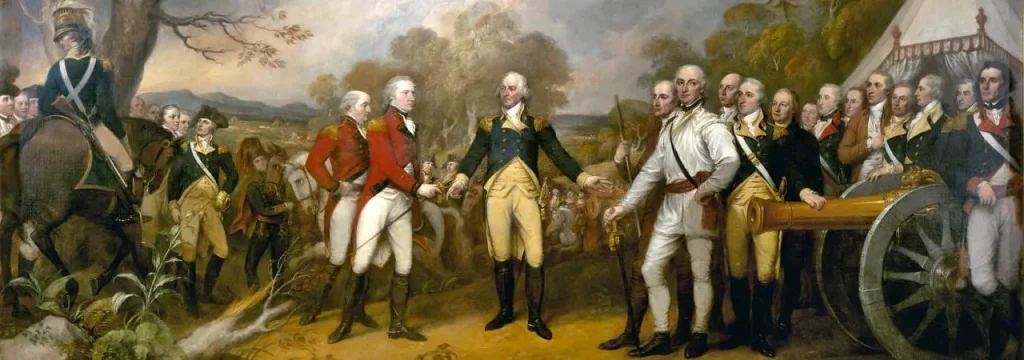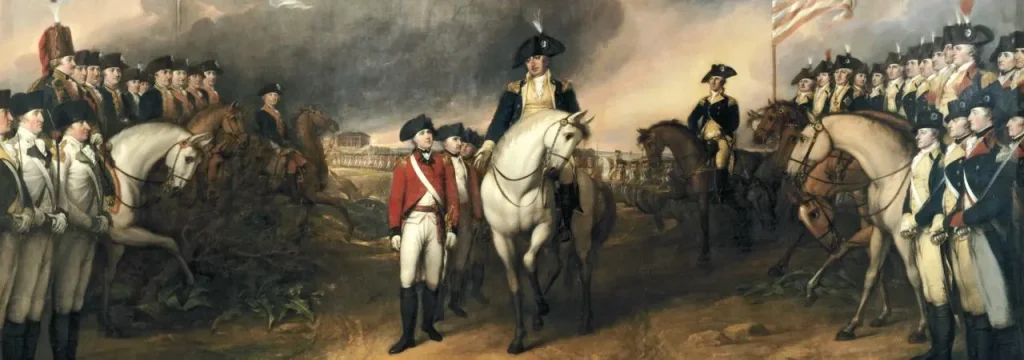The roots of the American Revolution can be traced back to the French and Indian War, which ended in 1763. This conflict had a lasting impact on the relationship between the British colonies in North America and the British Empire. The war had left the British government with a significant debt, and they sought to recoup their losses by imposing a series of taxes and restrictions on the colonies.
One of the first and most controversial measures was the Stamp Act, which required all printed materials in the colonies to bear an official stamp, for which a tax had to be paid. This tax was seen by the colonists as a violation of their rights as British subjects, as they had no representation in the British Parliament. The colonists organized widespread protests and boycotts, and the Stamp Act was eventually repealed, but it set the stage for further tensions between the colonies and the Crown.
The British government continued to impose a series of taxes and trade restrictions on the colonies, including the Townshend Acts, which placed duties on imported goods such as glass, paint, and tea. The colonists, led by figures such as Samuel Adams and John Hancock, responded with further protests and boycotts, culminating in the Boston Massacre in 1770, where British soldiers fired on a crowd of protesters, killing several people.
The Stamp Act and its impact
Contents
- 1 The Stamp Act and its impact
- 2 The Boston Tea Party and its significance
- 3 The Continental Congress and the Declaration of Independence
- 4 Key battles and events of the American Revolution
- 5 The role of influential figures in the Revolution
- 6 The Treaty of Paris and the end of the Revolution
- 7 The legacy of the American Revolution
- 8 Final Thoughts
- 9 Author
The Stamp Act, passed by the British Parliament in 1765, was a significant turning point in the lead-up to the American Revolution. This tax, which required all printed materials in the colonies to bear an official stamp, was seen by the colonists as a violation of their rights as British subjects. They argued that they were being taxed without representation in the British Parliament, a principle that had been established in the English Bill of Rights of 1689.
The colonists responded with widespread protests and boycotts, refusing to pay the tax and organizing non-importation agreements to prevent the sale of British goods. The Sons of Liberty, a secret organization of patriotic colonists, led the charge against the Stamp Act, staging demonstrations and even attacking the homes of tax collectors.
The Stamp Act crisis was a pivotal moment in the growing rift between the colonies and the British Empire. It demonstrated the willingness of the colonists to resist what they saw as unjust and oppressive policies, and it set the stage for further conflicts that would ultimately lead to the American Revolution. The repeal of the Stamp Act in 1766 was a victory for the colonists, but it did not resolve the underlying tensions, and the British government continued to impose new taxes and trade restrictions on the colonies.

The Boston Tea Party and its significance
The Boston Tea Party, which occurred in 1773, was another pivotal event in the lead-up to the American Revolution. In response to the Tea Act, which gave the British East India Company a monopoly on tea sales in the colonies, a group of Boston patriots, disguised as Native Americans, boarded a British ship and threw the entire cargo of tea into the harbor.
The Boston Tea Party was a bold and defiant act of resistance against British rule, and it sparked a wave of outrage and retaliation from the British government. In response, the British Parliament passed a series of punitive measures known as the Intolerable Acts, which closed the port of Boston, restricted colonial self-government, and allowed for the quartering of British troops in private homes.
The Boston Tea Party and the Intolerable Acts were catalysts for the formation of the First Continental Congress, which brought together representatives from the thirteen colonies to coordinate a unified response to British policies. The Continental Congress issued a Declaration of Rights and Grievances, which asserted the colonists’ rights as British subjects and called for the repeal of the Intolerable Acts.
The Continental Congress and the Declaration of Independence
The First Continental Congress, which convened in Philadelphia in 1774, marked a significant turning point in the path to American independence. Delegates from the thirteen colonies came together to coordinate a unified response to the British government’s policies, which they saw as increasingly oppressive and unjust.
One of the key outcomes of the First Continental Congress was the Declaration of Rights and Grievances, which asserted the colonists’ rights as British subjects and called for the repeal of the Intolerable Acts. This document laid the groundwork for the eventual Declaration of Independence, which would be drafted and signed two years later.
The Second Continental Congress, which convened in 1775, took an even more decisive step towards independence. Faced with the outbreak of the American Revolutionary War, the Congress appointed George Washington as the commander-in-chief of the Continental Army and began to take steps towards the establishment of a new, independent nation. Finally, in 1776, the Continental Congress approved the Declaration of Independence, which formally severed ties with the British Empire and established the United States of America as a sovereign and independent country.
Key battles and events of the American Revolution
The American Revolutionary War, which lasted from 1775 to 1783, was a series of hard-fought battles and campaigns that ultimately led to the independence of the United States. The war began with the Battles of Lexington and Concord in 1775, where colonial militiamen clashed with British troops, marking the start of the armed conflict.
One of the most significant early victories for the colonists was the Battle of Bunker Hill, where the outnumbered American forces inflicted heavy casualties on the British troops, despite ultimately being forced to retreat. This battle demonstrated the determination and bravery of the colonial forces, and it inspired further resistance against British rule.
The war continued to rage on multiple fronts, with the Continental Army facing numerous challenges, including a lack of resources, equipment, and training. However, the leadership of George Washington, combined with the strategic brilliance of figures such as Nathanael Greene and the heroic actions of soldiers like the Marquis de Lafayette, helped the colonists to achieve a series of important victories, including the Battle of Saratoga in 1777 and the Battle of Yorktown in 1781, which effectively ended the war.
The role of influential figures in the Revolution
The American Revolution was driven by a diverse cast of influential figures, each of whom played a crucial role in the path to independence. Perhaps the most well-known is George Washington, the commander-in-chief of the Continental Army and the first president of the United States. Washington’s leadership, strategic acumen, and unwavering determination were instrumental in the colonists’ eventual victory over the British.
Another key figure was Thomas Jefferson, the primary author of the Declaration of Independence. Jefferson’s eloquent and visionary writing, which proclaimed the fundamental rights of “life, liberty, and the pursuit of happiness,” became the guiding principles of the new nation.
Other influential figures include Benjamin Franklin, a statesman, inventor, and diplomat who played a crucial role in securing French support for the American cause; John Adams, a fiery orator and one of the principal architects of the American system of government; and Alexander Hamilton, a brilliant military strategist and the first Secretary of the Treasury, who helped shape the economic and political foundations of the United States.

The Treaty of Paris and the end of the Revolution
The American Revolutionary War came to a formal end with the signing of the Treaty of Paris in 1783. This treaty, negotiated by a team of American diplomats including Benjamin Franklin, John Adams, and John Jay, officially recognized the United States as an independent nation and established the terms of peace between the new country and the British Empire.
The togelon login was a significant victory, as it not only secured their independence but also granted them significant territorial concessions, including the cession of British-held lands east of the Mississippi River. This expanded the new nation’s boundaries and laid the foundation for its future growth and expansion.
The end of the Revolutionary War, however, did not mark the end of the challenges facing the United States. The new nation faced a host of political, economic, and social challenges as it sought to establish a stable and effective system of government. The Articles of Confederation, the first governing document of the United States, proved to be inadequate, leading to the convening of the Constitutional Convention in 1787 and the eventual adoption of the U.S. Constitution.
The legacy of the American Revolution
The American Revolution had a profound and lasting impact on the course of world history. The establishment of the United States as an independent nation not only transformed the political and social landscape of North America but also inspired and influenced the development of democratic movements and ideals around the globe.
The principles enshrined in the Declaration of Independence, such as the inalienable rights to “life, liberty, and the pursuit of happiness,” became powerful symbols of freedom and self-determination that resonated far beyond the borders of the new nation. The American Revolution also served as a model for other colonies and territories seeking to break free from the grip of imperial powers, paving the way for the emergence of numerous independent nations in the centuries that followed.
The legacy of the American Revolution can also be seen in the enduring influence of its key figures and the institutions they helped to establish. The U.S. Constitution, with its system of checks and balances and its protection of individual rights, has become a blueprint for democratic governance around the world. The ideals of the Founding Fathers, such as George Washington’s commitment to civilian control of the military and Thomas Jefferson’s vision of a nation of small, independent farmers, continue to shape the American political and social landscape to this day.
Final Thoughts
The American Revolution was a pivotal moment in world history, transforming a collection of British colonies into a united, independent nation. The journey from the early protests and boycotts to the iconic Boston Tea Party, the formation of the Continental Congress, and the eventual Declaration of Independence was fueled by the passionate desire for liberty and self-governance.
The Revolutionary War, with its battles, campaigns, and the heroic actions of its leaders and soldiers, ultimately led to the establishment of the United States of America. The legacy of the American Revolution continues to inspire and influence democratic movements around the world, and the principles and ideals it championed – such as individual rights, self-determination, and the pursuit of happiness – remain at the core of the American identity.
As we reflect on the American Revolution, we are reminded of the power of the human spirit to overcome adversity, to fight for freedom, and to shape the course of history. The stories of the Revolution’s unsung heroes, the Founding Fathers’ visionary leadership, and the sacrifices made by the brave men and women who fought for their independence continue to captivate and inspire us, reminding us of the enduring significance of this transformative event in the annals of world history.
Also read: Finland: The Secret to Nordic Happiness





